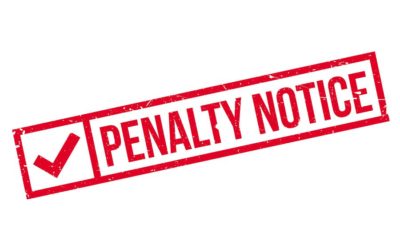Tax Court Holds Payroll Tax Filing Prevents Jurisdiction to Hear Worker Classifcation Case
Overview
In Reflectxion Resources, Inc. v. Commissioner, T.C. Memo. 2020-114 (August 3, 2020)(link), the U.S. Tax Court held that a Notice of Determination of Worker Classification (“NDWC”) was not in and of itself sufficient to provide the Tax Court with jurisdiction for all payroll tax periods raised in Reflectxion Resources, Inc.’s (“Taxpayer”) petition.
In order for the Tax Court to have jurisdiction under § 7436,
“there must be a certain kind of “determination” by the IRS–i.e., either a determination that someone is an “employee” of the person whose return is being audited (whom we will call “the taxpayer”) or a determination that the taxpayer is not entitled to section 530 treatment. If the IRS has made one or both of such determinations, there may be jurisdiction. If it has not, then there can be no jurisdiction in the Tax Court.”[1]
In total, the IRS was seeking to make adjustments and corresponding assessments against Taxpayer for 16 quarters. The IRS issued a NDWC for all 16 periods and the IRS had denied relief under section 530 for all periods. However, the Tax Court determined that it only had jurisdiction for 11 of the 16 periods. So, what was the difference?
For 5 of the 16 quarterly tax periods, the Taxpayer had already filed Form 941’s and had therefore taken the position that the medical staff that it had contracted with were employees. Therefore, the Tax Court reasoned that since the NDWC was not reclassifying individuals reported as independent contractors to employees nor denying section 530 treatment, there was no underlying controversy under § 7436 for the 5 periods that Taxpayer filed employment tax returns. The Tax Court dismissed these periods for lack of jurisdiction under § 7436.
If the Taxpayer wishes to challenge the reclassification of reimbursements to wages, then the Taxpayer will have to go through the additional time and expense of appealing to the Federal circuit court or initiating a refund claim suit in Federal district court.
However, for the other 11 periods, the payroll tax obligations had been handled by a payroll servicer. For those periods, the Tax Court determined that the Taxpayer had not treated the workers as employees for purposes of Section 530. The Tax Court ligation for the other 11 periods can continue.
Taxpayer’s Filing History & IRS Examination
The Taxpayer was a medical staffing agency that hired therapists to work for client medical facilities. Under an agreement between Taxpayer and a payroll servicer (“G”), G was a “co-employer’ under Florida law. For 11 payroll tax periods, G paid the wages and payroll tax liabilities associated with Taxpayer’s staffing agency. G filed the relevant payroll tax returns. Taxpayer then reimbursed G for those expenses.
After those 11 periods for which G undertook the payroll and payroll tax compliance responsibilities, Taxpayer paid the medical staff, filed federal payroll tax returns, and paid the associated payroll taxes for 5 payroll tax periods. On those payroll tax returns, Taxpayer took the position that it was the employer of the medical staff (rather than an independent contractor). For all 16 periods, the medical staff received reimbursement for travel expenses.[2]
The IRS examined all 16 periods and took the position that the reimbursed travel expenses should be reclassified as wages. The Taxpayer filed a protest and the case was then assigned to be reviewed by IRS Appeals. Appeals sided with the IRS and so the IRS issued a NDWC to Taxpayer, directly (rather than to G), for all 16 periods.
Tax Court’s Limited Jurisdiction for Employment Tax Cases
If the IRS adjusts a taxpayer’s income tax return, then the taxpayer usually has two main avenues to challenge the liability: U.S. Tax Court and U.S. Federal District Court. Tax Court is considered a “prepayment” forum because the taxpayer can usually challenge the IRS’s adjustments before the IRS assesses the tax and seeks to collect the liability.
However, not all adjustments or penalties are eligible for Tax Court jurisdiction. If a taxpayer cannot go to Tax Court, then a taxpayer can generally pay the tax or penalty and then seek a refund from the IRS. Assuming the refund will be denied, then the taxpayer can institute a refund suit in U.S. Federal district court. [3]
Section 7436 provides the Tax Court with limited jurisdiction to hear employment tax cases.
Section 7436(a):
(a)Creation of remedy -If, in connection with an audit of any person, there is an actual controversy involving a determination by the Secretary as part of an examination that—
(1) one or more individuals performing services for such person are employees of such person for purposes of subtitle C, or
(2) such person is not entitled to the treatment under subsection (a) of section 530 of the Revenue Act of 1978 with respect to such an individual,
upon the filing of an appropriate pleading, the Tax Court may determine whether such a determination by the Secretary is correct and the proper amount of employment tax under such determination. Any such redetermination by the Tax Court shall have the force and effect of a decision of the Tax Court and shall be reviewable as such.
[Emphasis Added]
Basically, the Tax Court can only hear cases that involve the reclassification of independent contractors to employees; Tax Court does not have jurisdiction to hear a case simply because the IRS adjusts an employer’s employment tax liability (i.e., due to an increase in wages).[4] However, other underpayments of employment tax not based on mischaracterization of the employee are not within the Tax Court’s jurisdiction.[5]
This requirement applies on a period by period basis. Therefore, if the Tax Court has jurisdiction for one or more periods it does not necessarily mean that the court has jurisdiction over every period.[6]
Section 530 Relief
Sometimes the line between contractor and employee is not always clear. For a worker that is properly classified by a business as an independent contractor, the business does not owe any employment taxes. On the other hand, if the individual is inappropriately classified as contractor, then the IRS can reclassify the worker as an employee and assess the business unpaid employment taxes, penalties, and interest.
Businesses can voluntarily reclassifies workers as employees by using the Voluntary Classification Settlement Program (“VCSP”).[7] Generally, the business must enter the program before being contacted by the IRS regarding the classification issue. However, if the IRS conducts an examination, then the forced reclassification of a large number of workers over multiple periods can lead to a very significant bill from the IRS.
Congress sought to provide some relief from the harsh consequences of such reclassifications for businesses that were erroneously treating workers as contractors in good faith and with a reasonable basis. The result was Section 530 of the Revenue Act of 1978 (“Section 530”).[8]
A detailed discussion of section 530 is beyond the scope of this post. Nevertheless, the three general criteria in the statute are generally referred to as: (i) Reporting Consistency: treating the workers an independent contract and issuing appropriate Form(s) 1099; (ii) Substantive Consistency: treating all similarly situated workers consistency; and (iii) Reasonable Basis: the taxpayer relied on a judicial precedent, a published ruling, a private letter ruling or technical advice memorandum issued to the taxpayer; the results of an employment tax audit of the taxpayer that takes place after 1996; a long-standing recognized practice of a significant segment of the industry in which the worker is engage, or any other reasonable basis.[9]
If a taxpayer satisfies each of the requirements, then no adjustment will be made and the taxpayer may continue treating workers within the class as non-employees. If some of the criteria are met or if it is not clear to the IRS that they met, then the IRS may settle the issue under the Classification Settlement Program. [10]
The Court emphasized potions of the statute showing that section 530 required
SEC. 530. CONTROVERSIES INVOLVING WHETHER INDIVIDUALS ARE EMPLOYEES FOR PURPOSES OF THE EMPLOYMENT TAXES.
(a) Termination of Certain Employment Tax Liability * * *–
(1) In general.–If—
(A) for purposes of employment taxes, the taxpayer did not treat an individual as an employee for any period * * *, and
(B) in the case of periods after December 31, 1978, all Federal tax returns (including information returns) required to be filed by the taxpayer with respect to such individual for such period are filed on a basis consistent with the taxpayer’s treatment of such individual as not being an employee,
then, for purposes of applying such taxes for such period with respect to the taxpayer, the individual shall be deemed not to be an employee unless the taxpayer had no reasonable basis for not treating such individual as an employee.
[Emphasis per TC Opinion]
Court’s Must Be Presented with a “Controversy”
Generally, all court cases require a “controversy.” Stated more simply, there must be a disagreement between the two parties on a matter that the court has jurisdiction over. In the context of this case, the Tax Court stated:
If during an audit the IRS purports to make a determination that a given individual is the employee of the taxpayer, but the taxpayer had admitted that the individual was an employee and had treated him as an employee, then there is no “actual controversy” about employee status and no jurisdiction in the Tax Court. Or if the IRS makes a purported determination that the taxpayer is not entitled to section 530 treatment, but the taxpayer had not claimed section 530 treatment, then there is no “actual controversy” about section 530 and no jurisdiction in the Tax Court.[11]
In Reflectxion, the Tax Court split the § 7436 jurisdictional analysis between the 11 periods where G, the payroll servicer took care of the employment tax obligations and the 5 periods where the Taxpayer took care of employment tax obligations.
Denial of Section 530 Relief Provides a Controversy
For the 11 periods where G took care of employment tax obligations, the Taxpayer had not treated the workers as employees and therefore there was a possibility of section 530 relief. The Taxpayer sought relief under section 530, which the IRS denied in the NDWC. Thus, the IRS’s NDWC provided an “actual controversy” because the IRS denied the taxpayer’s request for relief under section 530.[12] The court concluded:
“in the words of section 7436(a), for those periods there was an ‘actual controversy’; and the IRS made a ‘determination’—’in connection with an audit’ and ‘as part of an examination’–that petitioner “is not entitled to the treatment under subsection (a) of section 530’.”
Five Periods Lacked A “Controversy”
For the 5 periods for which the Taxpayer filed payroll tax returns, the Taxpayer had essentially taken the position the workers were employees by filing a Form 941 and reporting the amounts paid to the workers as wages. The Tax Court pointed out that relief under Section 530 is predicated on a reclassification of a worker form an independent contractor to an employee. Although the IRS’s NDWC (determination) for those five periods states that the workers are classified as employees and section 530 relief is not applicable, the IRS did not need to reclassify the workers as employees because the Taxpayer already treated them as employees. As a result, the Tax Court concluded that there was no “controversy”. [13]
Conclusion
The Reflectxion case suggests that if a business self-reports its workers as employees for a given tax period, then the business is not able to challenge employment tax adjustments for that period in Tax Court under § 7436. Instead, the business can challenge the adjustment in IRS Appeals, but, if Appeals does not yield a satisfying outcome, the business can only challenge the result in a Federal district court refund suit.
Notes:
[1] Reflectxion Resources, Inc. v. Commissioner at 19.
[2] Per the opinion:
The IRS examined petitioner’s employment tax liabilities for the periods at issue, and its examiners determined that petitioner’s travel reimbursement plan violated the accountable plan rules provided in section 62 and its accompanying regulations. Specifically, respondent found that petitioner paid per diem payments, mileage, and other travel expenses to travel therapists who petitioner failed to properly determine were performing services while traveling “away from home” within the meaning of section 162(a)(2)–an issue we do not resolve in this opinion. The IRS examiners further determined that petitioner’s travel reimbursement practice constituted “wage recharacterization” in violation of section 1.62-2(d) of the Income Tax Regulations.
[3] See generally, Publication 5146 Employment Tax Returns: Examinations and Appeal Rights (link) for a discussion of avenues to challenge the results of an employment tax exam.
[4] See Publication 5146 Employment Tax Returns: Examinations and Appeal Rights (link)
[5] As the court noted: “For example, an employer might simply fail to report the wages that it paid as such to employees. Or it might fail to report payments that are wages but that the employer did not treat as wages. Or it might make computational errors in reporting wages”
[6] See Reflectxion at 25.
[7] For more on the VCSP program, see the IRS website: link.
[8] Revenue Act of 1978, Pub. L. No. 95-600, sec. 530, 92 Stat. at 2885.
[9] For more on section 530 and the criteria, see the IRS Webpage Worker Reclassification – Section 530 Relief (link); IRM 4.23.6.2 (04-22-2014) (link). These three criteria are used in conjunction with the Classification Settlement Program, which provides various levels of relief depending on how many of the criteria the taxpayer has met. See IRM Part 4. Examining Process |Chapter 23. Employment Tax| Section 6. Classification Settlement Program (CSP) (link).
[10] IRS IRM 4.23.6.10 (12-21-2017) Eligible for Section 530 Relief. If a taxpayer meets some but not all of the section 530 criteria or if the IRS Appeals believes that there are hazards of litigation on some of the criteria, then the IRS may limit adjustment to on tax year and/or reduce the amount of the tax liability and penalties for prior periods through the IRS’s Classification Settlement Program. See IRS IRM Part 4. Examining Process |Chapter 23. Employment Tax| Section 6. Classification Settlement Program (CSP)https://www.irs.gov/irm/part4/irm_04-023-006.
[11] Reflectxion at 21.
[12] In a footnote, the Tax Court also noted that there might be an issue of whether the Taxpayer was actually the “employer”, for purposes of redetermination of employment tax liabilities, given the relationship with G. See Reflectxion at FN8.
[13] This seems like a bit of linguistical sleight of hand. The Tax Court acknowledges that the IRS did issue a NDWC and the taxpayer did make a request for section 530 relief, which was rejected. However, the court essentially boils it down to the point that there was no reasonable basis for such a request for section 530 relief so no controversy.
It is interesting to note that, based upon some language in the opinion, IRS counsel seemed to be okay with jurisdiction. Perhaps counsel was looking for a judgment on the merits.
It seems likely that if the IRS made a motion for summary judgment that it would have been successful for the five periods that the Taxpayer self-reported (i.e., even if the facts are viewed in the light most favorable to the taxpayer, there was no possible relief because Taxpayer had treated the workers as employees).



